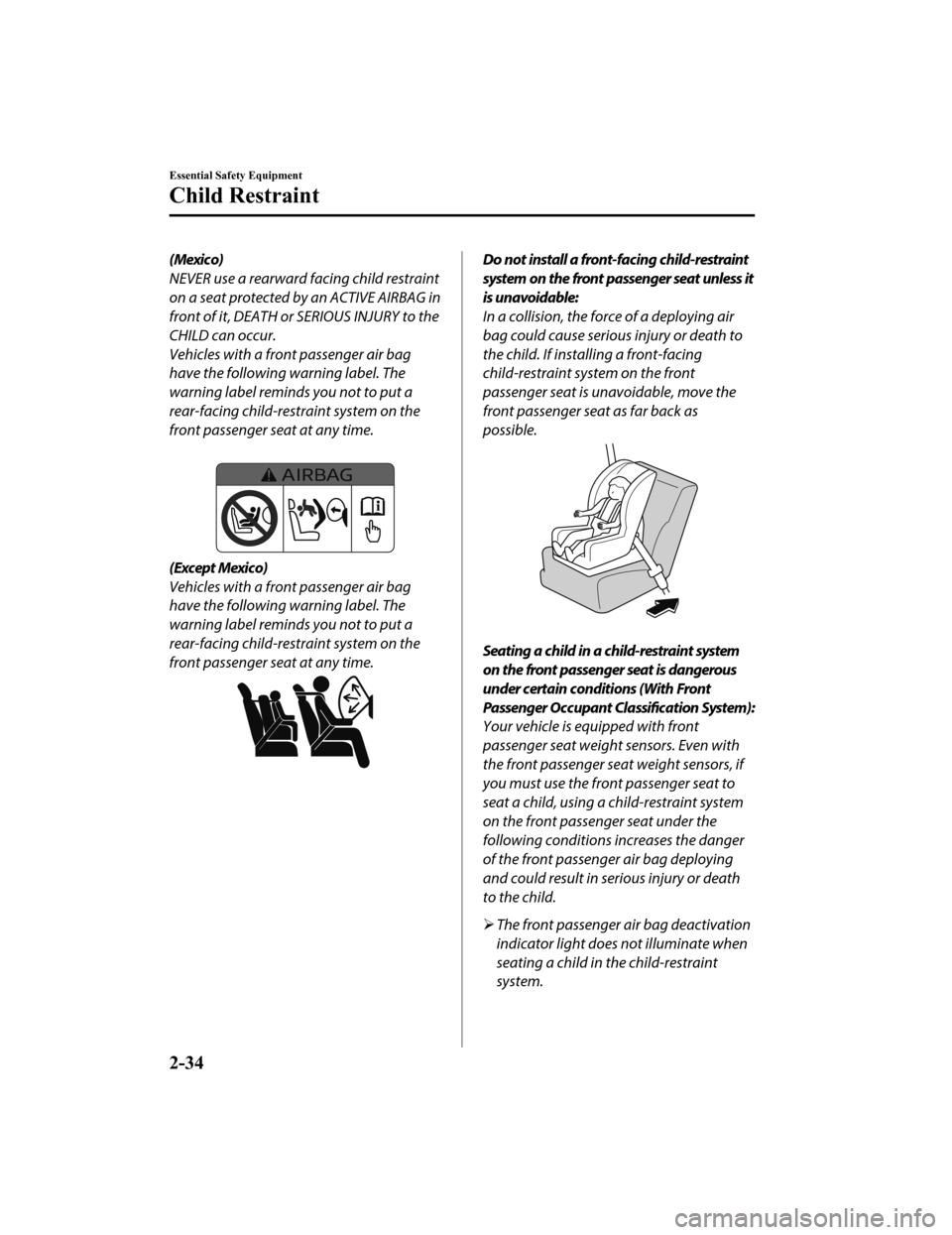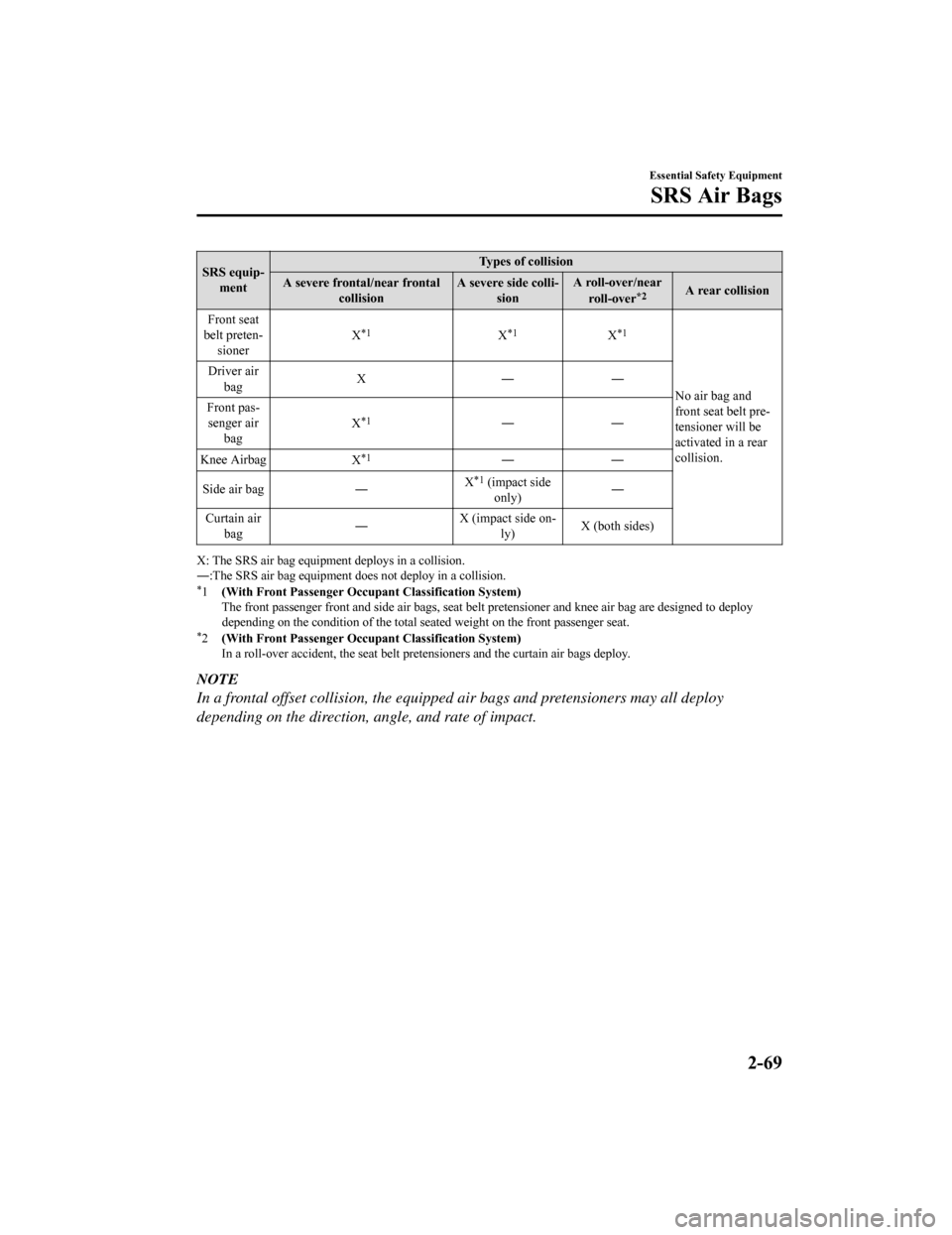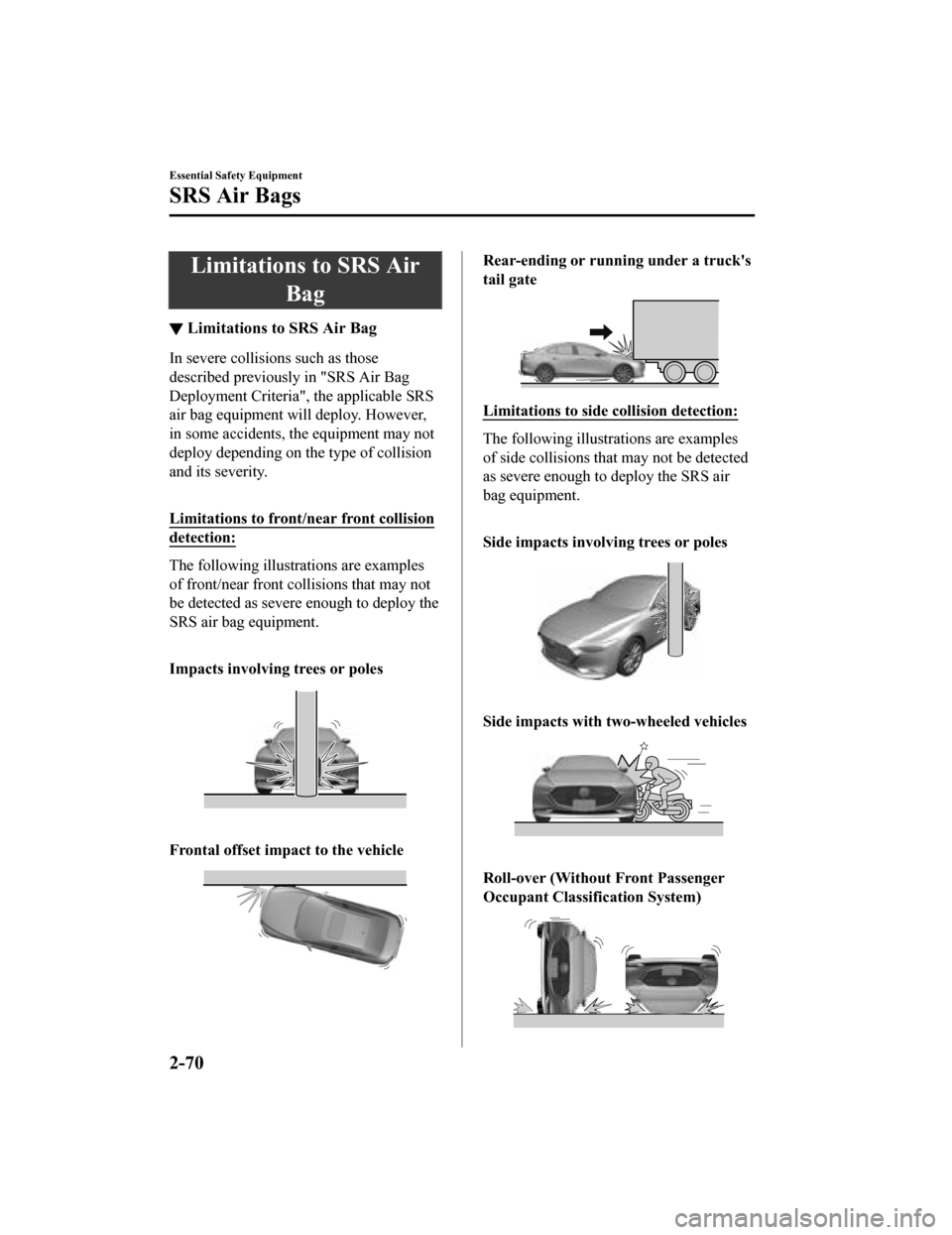airbag MAZDA MODEL 3 HATCHBACK 2019 Owners Manual (in English)
[x] Cancel search | Manufacturer: MAZDA, Model Year: 2019, Model line: MODEL 3 HATCHBACK, Model: MAZDA MODEL 3 HATCHBACK 2019Pages: 592, PDF Size: 12.19 MB
Page 48 of 592

(Mexico)
NEVER use a rearward facing child restraint
on a seat protected by an ACTIVE AIRBAG in
front of it, DEATH or SERIOUS INJURY to the
CHILD can occur.
Vehicles with a front passenger air bag
have the following warning label. The
warning label reminds you not to put a
rear-facing child-restraint system on the
front passenger seat at any time.
(Except Mexico)
Vehicles with a front passenger air bag
have the following warning label. The
warning label reminds you not to put a
rear-facing child-restraint system on the
front passenger seat at any time.
Do not install a front-facing child-restraint
system on the front passenger seat unless it
is unavoidable:
In a collision, the force of a deploying air
bag could cause serious injury or death to
the child. If installing a front-facing
child-restraint system on the front
passenger seat is unavoidable, move the
front passenger seat as far back as
possible.
Seating a child in a child-restraint system
on the front passenger seat is dangerous
under certain conditions (With Front
Passenger Occupant Classification System):
Your vehicle is equipped with front
passenger seat weight sensors. Even with
the front passenger seat weight sensors, if
you must use the front passenger seat to
seat a child, using a child-restraint system
on the front passenger seat under the
following conditions increases the danger
of the front passenger air bag deploying
and could result in serious injury or death
to the child.
The front passenger air bag deactivation
indicator light does not illuminate when
seating a child in the child-restraint
system.
Essential Safety Equipment
Child Restraint
2-34
Mazda3_8HE9-EA-18K_Edition1 2018-10-17 19:05:10
Page 61 of 592

▼If You Must Use th
e Front Seat for
Children
If you cannot put all children in the rear
seat, at least put the smallest children in
the rear and be sure the largest child up
front uses the shou lder belt over the
shoulder.
NEVER put a rear-fac ing child-restraint
system on the front passenger seat whether
your vehicle is equipped with an occupant
classification sensor or not.
This seat is also not set up for tethered
child-restraint systems, put them in one of
the rear seat positions set up with tether
anchors.
Likewise the ISOFIX/LATCH
*1
child-restraint system cannot be secured in
the front passenger's seat and should be
used in the rear seat.
Do not allow anyone to sleep against the
side window since your vehicle has side
and curtain air bags, it could cause serious
injuries to an out of position occupant. As
children more often sleep in cars, it is
better to put them in the rear seat. If
installing the child-restraint system on the
front seat is unavoidable, follow these
instructions when using a front-facing
child-restraint system in the front
passenger's seat.
*1 ISOFIX (Mexico)/LATCH (Except Mexico)
NOTE
To check if your front seats have side air
bags:
Mazda vehicles equipped with side air
bag will have a "SRS AIRBAG" tag on
the outboard shoulder of the front seats.
To check if your vehicle has curtain air
bags:
Mazda vehicles equipped with curtain
air bag will have an "SRS AIRBAG"
marking on the window pillars along the
roof edge.
WA R N I N G
Always move the front passenger seat as
far back as possible if installing a
front-facing child-restraint system on it is
unavoidable:
As your vehicle has front air bags and
doubly so because your vehicle has side air
bags, a front-facing child-restraint system
should be put on the front passenger seat
only when it is unavoidable.
Even if the front passenger air bag
deactivation indicator light illuminates,
always move the seat as far back as
possible, because the force of a deploying
air bag could cause serious injury or death
to the child.
Never use a rear-facing child-restraint
system in the front seat with an air bag
that could deploy:
Rear-facing child-restraint systems on the
front seat are particularly dangerous.
Even in a moderate collision, the
child-restraint system can be hit by a
deploying air bag and moved violently
backward resulting in serious injury or
death to the child. Even though you may
feel assured that the front passenger air
bag will not deploy based on the fact that
the front passenger air bag deactivation
indicator light illuminates, you should not
use a rear-facing child-restraint system in
the front seat.
Essential Safety Equipment
Child Restraint
2-47
Mazda3_8HE9-EA-18K_Edition1 2018-10-17 19:05:10
Page 69 of 592

Supplemental Restraint
System (SRS) Precautions
▼ Supplemental Restraint System
(SRS) Precautions
The front and side supplemental restraint
systems (SRS) include
different types of
air bags. Please verify the different types
of air bags which are equipped on your
vehicle by locating the “SRS AIRBAG”
location in dicators. These indicators are
visible in the area where the air bags are
installed.
The air bags are insta lled in the following
locations:
The steering wheel hub (driver air bag)
The front passenger dashboard (front
passenger air bag)
Under the instrument panel (driver and
front passenger
* knee air bags)
The outboard sides of the front
seatbacks (side air bags)
The front and rear window pillars, and
the roof edge along both sides (curtain
air bags)
Vehicles with the Front Passenger
Occupant Classification System have a
sensor which detects an impending
roll-over accident.
The air bag supplemental restraint systems
are designed to provide supplemental
protection in certain situations so seat belts
are always important in the following
ways:
Without seat belt usage, the air bags
cannot provide adequate protection during
an accident. Seat belt usage is necessary
to:
Keep the occupant from being thrown
into an inflating air bag.
Reduce the possibility of injuries during
an accident that is not designed for air
bag inflation, such as rear impact.
Reduce the possibility of injuries in
frontal, near frontal or side collisions or
roll-over accidents that are not severe
enough to activate the air bags.
Reduce the possibility of being thrown
from your vehicle.
Reduce the possibility of injuries to
lower body and legs during an accident
because the air bags provide no
protection to these p arts of the body.
Hold the driver in a position which
allows better control of the vehicle.
Essential Safety Equipment
SRS Air Bags
*Some models.2-55
Mazda3_8HE9-EA-18K_Edition1 2018-10-17 19:05:10
Page 83 of 592

SRS equip‐ment Types of collision
A severe frontal/near frontal collision A severe side colli‐
sion A roll-over/near
roll-over
*2A rear collision
Front seat
belt preten‐ sioner X
*1X*1X*1
No air bag and
front seat belt pre‐
tensioner will be
activated in a rear
collision.
Driver air
bag X――
Front pas‐ senger air bag X
*1――
Knee Airbag X
*1――
Side air bag ― X
*1 (impact side
only) ―
Curtain air bag ―X (impact side on‐
ly) X (both sides)
X: The SRS air bag equipment deploys in a collision.
―:The SRS air bag equipment does not deploy in a collision.
*1
(With Front Passenger Occupa nt Classification System)
The front passenger front and si de air bags, seat belt pretensioner and knee air bag are designed to deploy
depending on the condition of the total seated weight on the front passenger seat.
*2 (With Front Passenger Occupa nt Classification System)
In a roll-over accident, the seat belt pretensioners and the cu rtain air bags deploy.
NOTE
In a frontal offset collision, the equipped air bags and pretensioners may all deploy
depending on the direction, angle, and rate of impact.
Essential Safety Equipment
SRS Air Bags
2-69
Mazda3_8HE9-EA-18K_Edition1 2018-10-17 19:05:10
Page 84 of 592

Limitations to SRS AirBag
▼Limitations to SRS Air Bag
In severe collisions such as those
described previousl
y in "SRS Air Bag
Deployment Criteria", the applicable SRS
air bag equipment will deploy. However,
in some accidents, the equipment may not
deploy depending on the type of collision
and its severity.
Limitations to front/near front collision
detection:
The following illustrations are examples
of front/near front collisions that may not
be detected as severe enough to deploy the
SRS air bag equipment.
Impacts involving trees or poles
Frontal offset imp act to the vehicle
Rear-ending or running under a truck's
tail gate
Limitations to side collision detection:
The following illustrations are examples
of side collisions that may not be detected
as severe enough to deploy the SRS air
bag equipment.
Side impacts involving trees or poles
Side impacts with two-wheeled vehicles
Roll-over (Without Front Passenger
Occupant Classification System)
Essential Safety Equipment
SRS Air Bags
2-70
Mazda3_8HE9-EA-18K_Edition1 2018-10-17 19:05:10